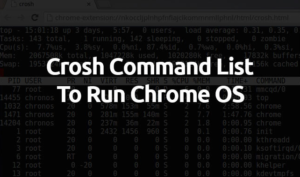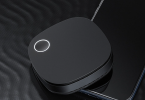What do you know about Crosh Terminal Commands? Do you know that Chromebooks have a built-in terminal? If no, then we are here to tell you many interesting things about the Chromebook terminal. Well, the Chromebook terminal is known as Chrome OS Developer Shell—or Crosh for short. Also, it enables you to access a command-line interface that you can use to debug your machine, execute tests, or simply poke around for fun.
Here are many terminal commands that all users know about for improved productivity or troubleshooting:
Contents [hide]
- 1 Crosh Terminal Commands For Chromebook:
- 2 Crosh Terminal Commands Explanation:
- 2.1 Open Crosh
- 2.2 Run a Ping Test
- 2.3 Memory Test
- 2.4 Modify Your Mouse’s Acceleration Rate
- 2.5 Modify Keyboard Repeat Rate
- 2.6 Modem Configuration
- 2.7 Reinstall the Previous Version of Chrome OS
- 2.8 Stop Any Process in Crosh
- 2.9 A Better Task Manager
- 2.10 Battery Management
- 2.11 Developer Mode Commands
- 2.12 Users and Uptime
- 2.13 Modify the Time
- 2.14 More Network Diagnostics
- 2.15 Record Audio
- 2.16 Trace the Network
- 2.17 Help
- 2.18 Exit Crosh
- 3 Make Backups Before You Start
Crosh Terminal Commands For Chromebook:
We’ll explain all these commands, but here’s the TL;DR model:
- Open Crosh: Ctrl + Alt + T
- Ping: ping [domain]
- Test memory: memory_test
- Modify mouse settings: xset m
- Change keyboard settings: inputcontrol
- Modem Configuration: modem help
- Rollback Chrome OS: rollback
- Stop a process in Crosh: Ctrl + C
- Open Task Manager: top
- Battery Manager: battery_test [seconds]
- Developer Mode commands: shell, systrace, packet_capture
- Users and uptime: uptime
- Time settings: set_time
- Network diagnostics: network_diag
- Record audio: record [seconds]
- Network trace: tracepath
- Help: help, help_advanced
- Exit Crosh: exit
Crosh Terminal Commands Explanation:

Open Crosh
You can’t find the Chrome OS Developer Shell in the list of apps in your Chromebook’s app tray.
If you want to open the Crosh, simply hit Ctrl + Alt + T, which launches the terminal window in a new browser tab.
Note: You don’t want to have your Chromebook’s Developer Mode turned on to access Crosh.
Run a Ping Test
Input ping [domain] to execute a ping test on your Chromebook.
In case you don’t know, ping tests are useful tools after trying to diagnose network problems. It will allow you to know how fastly traffic is traveling between your PC and a web server. It will also inform you if there are any dropped packets.
Memory Test
Also, you can view information about your Chromebook’s memory using third-party plugins. If you need more detailed information, then use Crosh. Just input memory_test and press Enter.
Modify Your Mouse’s Acceleration Rate
You can also organize or manage your mouse’s basic speed using the Chrome OS settings menu. Move to Settings > Device > Mouse and Touchpad > Mouse > Mouse Speed to make modifications.
However, if you like many powder level of control, you want to move into Crosh. Once you type xset m, you can modify how instantly your mouse accelerates when it begins moving.
Modify Keyboard Repeat Rate
You can also modify how fastly a letter repeats itself on the display screen once you hold down a single button on your keyboard.
Input xset r and follow the on-screen steps to get begin.
Note: The xset commands probably not work on the latest machines. If they can’t work for you, try inputcontrol instead.
Modem Configuration
Another i9mportant part is to ensure that your modem is configured perfectly.
Once you type modem help in the Chromebook’s terminal, you will then get access to different options. It includes settings to enable your modem, plug your modem, modify the modem’s firmware, factory reset your modem, and much more.
Reinstall the Previous Version of Chrome OS
Recently Chrome OS update has caused havoc with your PC, you can easily undo the modification and return to an earlier model of the operating system.
The command you want is rollback.
Stop Any Process in Crosh
If you want to stop any background process (such as a ping test) in Crosh, just hit Ctrl + C.
A Better Task Manager
Some people know that Chrome OS has its own task manager. It displays you what processes are eating through your memory or CPU. You can find it by opening Chrome and moving to More (three vertical dots) More Tools > Task Manager.
However, some people know that Chrome OS has a secondary task manager hidden in Crosh. You can also use it to learn more about low-level processes that can’t display up in the main task manager app.
Input top to get begin.
Battery Management
Again, you can view headline battery data merely after looking under the right-hand corner of your Chromebook’s screen.
However, if you like more information, write battery_test [seconds] into Crosh (replace [seconds] with a number, for instance, battery_test 10).
Crosh will display you precisely how much battery power your machine used in the required timeframe, or feedback on your remaining battery time and your battery’s health.
Developer Mode Commands
Although you don’t want to be a developer to use Crosh if you have Developer Mode enabled, you’ll have three new commands available to you:
- shell: Opens a full bash shell.
- systrace: Starts a system trace.
- packet_capture: Captures and logs data packets.
Users and Uptime
When was the last time you disabled your Chromebook? If you’re anything like me, you’ll move days—or also weeks—between reboots.
To view how long your PC has been executing for since its last shutdown, write uptime. The results also provide information about the users who are recently logged in.
Modify the Time
Do you have issues with your machine’s display time? Maybe you live on a border between time zones or have a WiFi connection using an IP address that frequently moves.
Input set_time into Crosh, and you can then override the operating system’s graphical interface time settings.
More Network Diagnostics
After running a ping test and tried configuring your modem but you are still facing issues, you can write network_diag to execute even more tests on your network.
The output is stored as a TXT file in your Chromebook’s Files app.
Record Audio
Chromebooks can’t come with a native audio recording tool. Fortunately, there are lots of apps in the Chrome Web Store that gives the functionality, but they are unnecessary.
In Crosh, enter sound record [seconds] (again, replacing [seconds] with a number) to record the amount of audio using your machine’s microphone.
Write sound_play to listen to what you take or find the latest audio file in the Files app.
Trace the Network
The last Crosh networking command on our list, tracepath allows you to route your PCs data packets take across a network.
Help
If we can’t cover the command you want, write help or help_advanced to view a full list of all the Crosh commands that are available to you.
Exit Crosh
When done exploring, input exit and Crosh will quit.
It’s as easy as that.
Make Backups Before You Start
It goes without saying that if you modify settings in the Chrome OS Developer Shell without knowing anything then you must render your PC unusable.
Hopefully, Chromebooks are quite easy to backup, but you would also lose any locally-saved data. As such, remember you create backups before you do too much moving around.
Conclusion:
Here’s all about “Crosh Terminal Commands”. If you want to share any other thing regarding the article then let us know below. For further queries and questions let us know in the comment section below!
Also Read:






